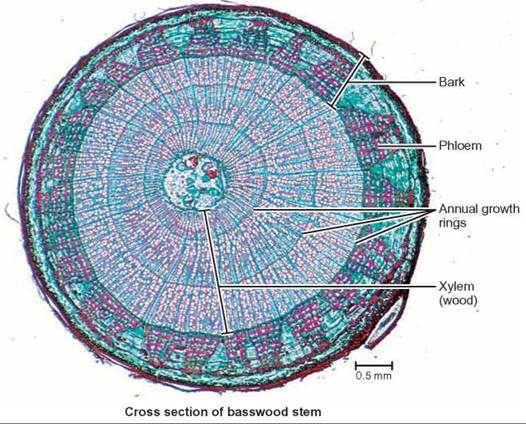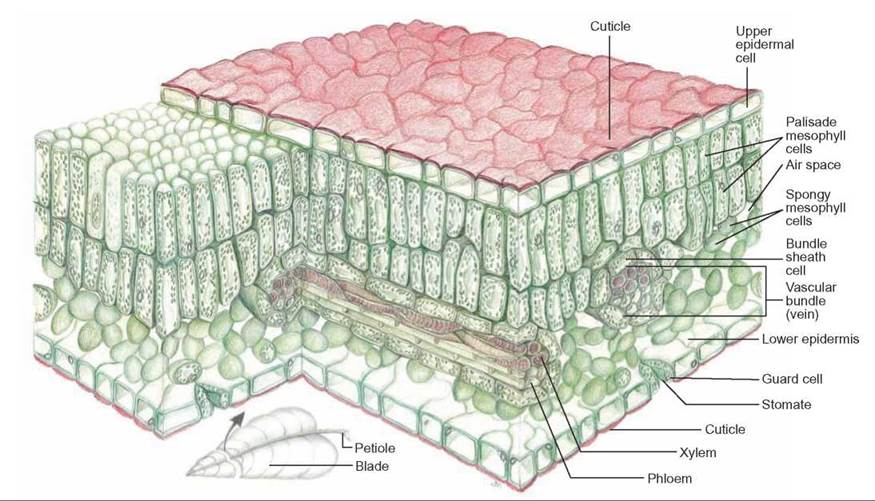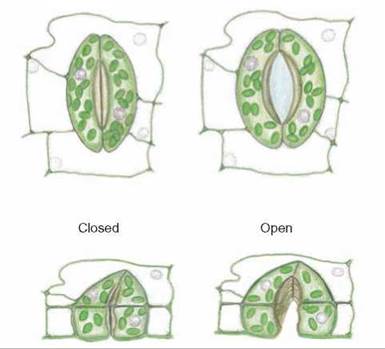CONCEPTS IN BIOLOGY
PART V. THE ORIGIN AND CLASSIFICATION OF LIFE
22. The Plants Kingdom
22.6. The Development of Roots, Stems, and Leaves
The development of plant parts that are specialized for particular functions is associated with the presence of vascular tissue because materials can be moved from one specialized plant organ to another by the vascular tissue (figure 22.8). Nearly all vascular plants have plant parts specialized as roots, stems, and leaves.

FIGURE 22.8. Vascular Tissue and the Specialization of Plant Parts
Vascular tissue allows for the specialization of leaves for photosynthesis, roots for the absorption of water and minerals, and stems for the positioning of the leaves. The xylem carries water and minerals from the roots to the leaves. The phloem transports organic molecules to places they are needed for growth or storage.
Roots
Roots are the underground parts of plants that anchor them in the soil and absorb water and nutrients, such as nitrogen, phosphorus, potassium, and other inorganic molecules from the soil. The xylem allows these materials to be distributed for use by other parts of the plant. The phloem transports organic molecules from the leaves and stem to the roots.
Roots grow from their tips. By growing constantly, roots explore new territory for available nutrients and water. As a plant becomes larger, it needs more root surface to absorb water and nutrients and to hold the plant in place. The actively growing portions of the root near the tips have many small, fuzzy, hairlike cell extensions called root hairs, which provide a large surface area for the absorption of nutrients and water.
Most roots are important storage places for the food produced by the above-ground parts of the plant. Food is stored in their roots during the growing season and used to stay alive during the winter. The food also provides the raw materials necessary for growth for the next growing season. Although humans do not eat the roots of plants such as maple trees, rhubarb, and grasses, their roots are as important to them in food storage as are those of carrots, turnips, and radishes (figure 22.9).

FIGURE 22.9. Kinds of Roots
The roots of grasses are often in the upper layers of the soil and form a dense network. This form of root is called a fibrous root and is an adaptation to relatively dry conditions. In grasslands, rainfall is infrequent and rarely penetrates very deeply into the soil. The network of roots near the surface efficiently captures the water when it is available. The roots of trees and many other plants typically extend deep into the soil, where they obtain moisture and serve as anchors to hold large plants upright. This kind of root is called a tap root.
Stems
Stems are, in most cases, the above-ground structures of plants that support the light-catching leaves in which photosynthesis occurs. However, they can vary considerably. Trees have stems that support large numbers of branches; vines have stems that require support; some plants, such as dandelions, have very short stems, with their leaves flat against the ground; and some stems are actually underground. Stems have two main functions:
1. They support the leaves.
2. They transport raw materials from the roots to the leaves and manufactured food from the leaves to the roots.
The support that stems provide is possible because of the nature of plant cell walls. First, all plant cells are surrounded by a cell wall made of cellulose fibers interwoven to form a box, within which the plant cell is contained. Because the cell wall consists of fibers, it is like a wicker basket. There are spaces between cellulose fibers through which materials pass relatively easily. However, the cellulose fibers do not stretch; if the cell is full of water and other cellular materials, it becomes quite rigid. Remember that the process of osmosis results in cells having an internal pressure. It is this pressure against the nonstretchable cell wall that makes the cell rigid. Many kinds of small plants, called herbaceous plants, rely primarily on this mechanism for support.
The second way stems provide support involves the thickening of cell walls. Woody plants have especially thick cell walls. The xylem of woody plants has thick cell walls and lignin deposited in the cell walls that provides strength and binds cell walls to one another. This combination of thick cell walls with strengthening lignin is such an effective support mechanism that large trees and bushes are supported against the pull of gravity and can withstand strong winds for centuries. Some of the oldest trees on Earth have been growing for several thousand years.
Another important function of the stem is to transport materials between the roots and the leaves (figure 22.10). A cross section of a stem examined under a microscope reveals that a large proportion of the stem consists of vascular tissue.

FIGURE 22.10. Cross Section of a Stem
This photo shows the cross section of a 3-year-old basswood tree. On the outside is the bark, which contains the phloem. Inside the bark are three layers of xylem tissue. Each layer of xylem constitutes 1 year’s growth.
In addition to support and transport, the stems of some plants have additional functions. Some stems store food. This is true of sugar cane, yams, and potatoes. (Yams and potatoes are actually highly modified underground stems.) Many plant stems are green and, therefore, are involved in photosynthesis. Cacti and many herbaceous plants are examples. Stems also have a waterproof layer on the outside. In the case of herbaceous plants, it is usually a waxy layer. In the case of woody plants, there is a tough, outer, waterproof bark.
Leaves
Leaves are the specialized parts of plants that are the major sites of photosynthesis. (See chapter 7 for a discussion of photosynthesis.) To carry out photosynthesis, leaves must have certain characteristics (figure 22.11). Because it is a solar collector, a leaf should have a large surface area. Also, most leaves are relatively thin, compared with other plant parts. Thick leaves would not allow the penetration of light to the maximum number of photosynthetic cells. Throughout the leaf are bundles of vascular tissue, which transport water and minerals to the photosynthesizing cells and sugars and other molecules from these cells. The thick walls of the cells of vascular tissue also provide support for the leaf. In addition, the leaves of most plants are arranged so that they do not shade one another. This assures that the maximum number of cells in the leaf will be exposed to sunlight.

FIGURE 22.11. The Structure of a Leaf
Although a leaf is thin, it consists of several specialized layers. An outer epidermis lacks chloroplasts and has a waxy cuticle on its surface. In addition, the epidermis has openings, called stomates, that can open and close to regulate the movement of gases into and out of the leaf. The internal layers have many cells with chloroplasts, air spaces, and bundles of vascular tissue all organized so that photosynthetic cells can acquire necessary nutrients and transport metabolic products to other locations in the plant.
A drawback to having large, flat, thin leaves is an increase in water loss through evaporation. To help slow water loss, the outermost layer of cells, known as the epidermal layer, has a waxy, waterproof coat on its outer surface. However, some exchange of gases and water must take place through the leaf. When water evaporates from the leaf, it creates a negative pressure, which tends to pull additional water and dissolved minerals through the xylem into the leaf, a process called transpiration. Because too much water loss can be deadly, the leaf must regulate transpiration. The amount of water, carbon dioxide, and oxygen moving into and out of the leaves of most plants is regulated by many tiny openings in the epidermis, called stomates (tigure 22.12). The stomates can close or open to control the rate at which water is lost and gases are exchanged. Often during periods of drought or during the hottest, driest part of the day, the stomates are closed, reducing the rate at which the plant loses water.

FIGURE 22.12. Stomates
The stomates are located in the covering layer (epidermis) on the outside of leaves. When these two elongated guard cells are swollen, the space between them is open and leaves lose water and readily exchange oxygen and carbon dioxide. In their less rigid and relaxed state, the two stomatal cells close. In this condition, the leaf conserves water but is not able to exchange oxygen and carbon dioxide with the outside air.
22.6. CONCEPT REVIEW
11. Describe two ways the structure of each of the following is related to its function.
a. roots
b. stems
c. leaves